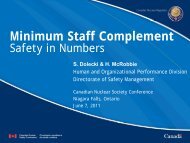Investigation of the Environmental Fate of Tritium in the Atmosphere
Investigation of the Environmental Fate of Tritium in the Atmosphere
Investigation of the Environmental Fate of Tritium in the Atmosphere
Create successful ePaper yourself
Turn your PDF publications into a flip-book with our unique Google optimized e-Paper software.
INVESTIGATION OF THE ENVIRONMENTAL FATE OF TRITIUM IN THE ATMOSPHERE<br />
Accidental airborne releases can raise <strong>the</strong> contribution <strong>of</strong> HT to values on <strong>the</strong> order <strong>of</strong> 60%<br />
<strong>of</strong> <strong>the</strong> total tritium discharged (Murphy and Pendergast, 1979). By comparison, <strong>the</strong> amount<br />
<strong>of</strong> tritium released <strong>in</strong> <strong>the</strong> liquid effluents seems to represent approximately 10% <strong>of</strong> <strong>the</strong><br />
airborne releases (NCRP, 1979). Releases from tritium production facilities can be reduced<br />
through <strong>the</strong> implementation <strong>of</strong> measures to optimize tritium yields dur<strong>in</strong>g process<strong>in</strong>g (Jacobs,<br />
1968).<br />
<strong>Tritium</strong> can also be produced <strong>in</strong> accelerators by bombard<strong>in</strong>g 3 He with neutrons (as depicted<br />
<strong>in</strong> Figure 2.4), although this approach has not been applied on a large scale (Zerriffi, 1996).<br />
<strong>Tritium</strong> can be formed <strong>in</strong> <strong>the</strong> light water cool<strong>in</strong>g <strong>of</strong> electron or proton accelerators primarily<br />
through spallation <strong>of</strong> <strong>the</strong> oxygen atoms <strong>in</strong> <strong>the</strong> water molecules. Small amounts <strong>of</strong> tritium<br />
can also be produced through spallation <strong>of</strong> nitrogen, carbon and o<strong>the</strong>r light molecules. It is<br />
possible that some releases <strong>of</strong> this tritium to <strong>the</strong> environment can occur through airborne<br />
releases and possibly liquid releases depend<strong>in</strong>g upon <strong>the</strong> design <strong>of</strong> <strong>the</strong> cool<strong>in</strong>g system.<br />
2.4.5 Consumer Products<br />
The fractional release <strong>of</strong> tritium, <strong>in</strong> <strong>the</strong> form <strong>of</strong> HTO, HT and short-cha<strong>in</strong> organic radicals<br />
<strong>of</strong> <strong>the</strong> styrene type, from lum<strong>in</strong>ous compounds (such as those used as dial pa<strong>in</strong>ts for <strong>the</strong><br />
illum<strong>in</strong>ation <strong>of</strong> timepieces), comprises approximately 5% annually (Comps and Doda, 1979;<br />
Krejci, 1979; Krejci and Zeller, 1979; UNSCEAR, 1977; Wehner, 1979). Such releases can<br />
represent amounts on <strong>the</strong> order <strong>of</strong> 10 14 Bq tritium per year (Krejci, 1979).<br />
<strong>Tritium</strong> releases from gas-filled tubes, such at those used <strong>in</strong> liquid crystal displays (LCDs)<br />
and <strong>in</strong>side exit signs or electronic tubes are negligible <strong>in</strong> comparison, show<strong>in</strong>g values <strong>of</strong><br />
approximately 2 x 10 12 Bq tritium per year (Krejci, 1979; UN, ILO and WHO, 1983). That<br />
said, however, environmental releases follow<strong>in</strong>g accidental breakage <strong>of</strong> tubes or improper<br />
disposal can be significant (Comps and Doda, 1979; Wehner, 1979).<br />
Mutch and Mahony (2008) reported tritium levels <strong>in</strong> municipal landfill leachates, which<br />
were attributed to disposal <strong>of</strong> such products. In a study <strong>of</strong> ten landfills <strong>in</strong> New York and<br />
New Jersey, <strong>the</strong> average tritium as HTO <strong>in</strong> leachate was 1,251 Bq/L and <strong>the</strong> maximum was<br />
7,104 Bq/L. A similar study <strong>of</strong> California landfills <strong>in</strong>dicated an average tritium <strong>in</strong> leachate<br />
<strong>of</strong> 3,663 Bq/L and a maximum <strong>of</strong> 11,248 Bq/L. Landfill gas condensates <strong>in</strong> U.K. and<br />
California studies had tritium concentrations as high as 2,013 Bq/L and 18, 981 Bq/L,<br />
respectively.<br />
BACK TO TABLE OF CONTENTS 22



